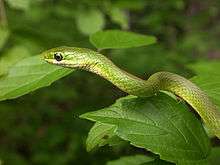Opheodrys
| Opheodrys | |
|---|---|
 | |
| Opheodrys aestivus | |
| Scientific classification | |
| Kingdom: | Animalia |
| Phylum: | Chordata |
| Subphylum: | Vertebrata |
| Class: | Reptilia |
| Order: | Squamata |
| Suborder: | Serpentes |
| Family: | Colubridae |
| Subfamily: | Colubrinae |
| Genus: | Opheodrys Fitzinger, 1843 |
| Synonyms | |
|
Anguis, Chlorosoma, Coluber, Contia, Cyclophis, Entechinus, Eurypholis, Herpetodryas, Leptophis, Liopeltis, Natrix, Phyllophilophis,[1] Liochlorophis | |
Opheodrys is a genus of small to medium-sized non-venomous colubrid snakes commonly referred to as green snakes. In North America the genus consists of two distinct species. As their common names imply, the Rough Green Snake has keeled dorsal scales, whereas the Smooth Green Snake has smooth dorsal scales.
Species
- Rough Green Snake, Opheodrys aestivus
- Smooth Green Snake, Opheodrys vernalis
Species removed from the genus
The genus Opheodrys at one time included two Asian species: O. herminae, which is endemic to Japan, and O. major, which is endemic to Central/South China, Taiwan, N. Vietnam, and Laos. These were removed from the genus by Cundall in 1981[2]
- Sakashima Green Snake, Opheodrys herminae (Boettger, 1895) = Cyclophiops herminae (Boettger, 1895)[3]
- Greater Green Snake, Opheodrys major (Günther, 1858) = Cyclophiops major (Günther, 1858)
The following subspecies of Opheodrys are no longer recognized:[4]
- Northern Rough Green Snake, Opheodrys aestivus aestivus (Linnaeus, 1766)
- Florida Rough Green Snake, Opheodrys aestivus carinatus Grobman, 1984
- Western Smooth Green Snake, Opheodrys vernalis blanchardi Grobman, 1941
- Eastern Smooth Green Snake, Opheodrys vernalis vernalis (Harlan, 1827)
- Northern Smooth Green Snake, Opheodrys vernalis borealis Grobman, 1992
Geographic range
Green snakes are found throughout the United States, southern Canada, northern Mexico, Japan, China, and Southeast Asia.
Description
Green snakes are so named because they are typically solid green in color dorsally, with a cream-colored or yellow underside. They are thin-bodied snakes that rarely exceed 90 cm (around 36 inches) in length. They have large eyes and blunt shaped heads.
Behavior
Green snakes are often found in dense, low lying vegetation near a permanent water source. They have been known to follow human activity. They rely on their color for camouflage and will usually attempt to escape if threatened.
Diet
Their primary diet is soft-bodied arthropods, including crickets, spiders, moths, butterflies, and grasshoppers.
Reproduction
Green snakes are oviparous.
References
Further reading
- Fitzinger, L. 1843. Systema Reptilium, Fasciculus Primus, Amblyglossae. Braumüller & Seidel. Vienna. 106 pp. (Opheodrys, p. 26.)
External links
- Genus Opheodrys at The Reptile Database
- Smooth Green Snake - Opheodrys vernalis Species account from the Iowa Reptile and Amphibian Field Guide
- Georgia Department of Natural Resources -- Laws Related to Native Wildlife
| Wikimedia Commons has media related to Opheodrys aestivus. |